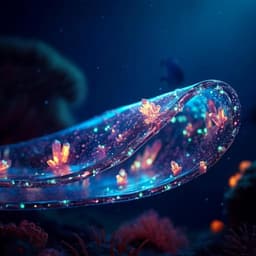Introduction
Organic-inorganic hybrid perovskite solar cells (PSCs) have garnered significant attention due to their attractive optoelectronic properties. However, their instability under ambient conditions and the high cost of materials like spiro-OMeTAD (used as a hole transport layer, HTL) hinder their widespread adoption. CuSCN, an inorganic HTL, presents a cost-effective alternative with higher hole mobility than spiro-OMeTAD. However, challenges remain: solvents used for CuSCN deposition can dissolve perovskite materials, and incomplete CuSCN coverage can lead to insufficient perovskite-HTL interaction. Interface engineering, such as incorporating a 2D perovskite layer on top of the 3D perovskite, has shown promise in enhancing stability and efficiency. Previous studies have demonstrated the use of alkylammonium halide perovskites and various amines to create such 2D interface layers, resulting in improved PCE and stability. This study aims to address the aforementioned limitations by investigating the use of p-Phenylenediaminium iodide (PDAI) to create a stable and efficient PSC with self-healing properties. The research will focus on the effects of PDAI on the morphology, charge transport properties, and stability of the perovskite film, ultimately seeking to improve the performance and commercial viability of PSCs.
Literature Review
Numerous studies have explored strategies to improve the stability and efficiency of PSCs. These include the use of different HTLs, such as inorganic materials like CuSCN, which offers advantages in terms of cost and hole mobility compared to spiro-OMeTAD. However, the challenges of solvent-induced perovskite dissolution and incomplete HTL coverage persist. Interface engineering, employing a 2D perovskite layer on top of a 3D perovskite structure, has proven effective in passivating interfacial defects and enhancing stability. Researchers have explored the use of various ammonium salts and amines to create these 2D layers, achieving improvements in PCE and moisture stability. Long-chain alkyl groups and phenyl groups within these molecules are reported to improve stability and efficiency by minimizing charge recombination and improving the interaction between the perovskite and HTL. While these methods show promise, the development of cost-effective and highly stable PSCs with self-healing capabilities remains an active area of research.
Methodology
The study employed p-Phenylenediaminium iodide (PDAI) for in-situ growth of a 2D (PDA)₂PbI₄ perovskite layer between a (FAPbI₃)₀.₈₅(MAPbBr₃)₀.₁₅ 3D perovskite layer and a CuSCN HTL. Materials were synthesized, including FAI, MABr, PDAI, and CuSCN, using established methods. Perovskite solar cells were fabricated using a standard process involving spin-coating onto FTO substrates, with various concentrations of PDAI (0, 3, 5, 7, 10, and 15 mg mL⁻¹) incorporated into the process. Characterization techniques included X-ray diffraction (XRD) to analyze crystal structure, field-emission scanning electron microscopy (SEM) for morphological analysis, UV-Vis spectroscopy for optical properties, and photoluminescence (PL) spectroscopy to study carrier recombination. Current-voltage (J-V) measurements under AM 1.5G illumination were conducted to assess device performance, including Jsc, Voc, FF, and PCE. Incident photon-to-current conversion efficiency (IPCE) was also measured. Stability tests involved humidity aging (90 ± 5% and 15 ± 5% RH) and thermal aging (85 °C at 15 ± 5% RH) to evaluate device longevity. Self-healing properties were examined by exposing devices to hot water vapor and observing their recovery after removal from the vapor.
Key Findings
The incorporation of 5 mg mL⁻¹ PDAI led to significant improvements in PSC performance and stability. SEM images revealed enlarged grain sizes and compact grain boundaries in the perovskite film with optimal PDAI concentration. PL measurements showed enhanced PL yield compared to the control sample, indicating reduced carrier recombination. The device with 5 mg mL⁻¹ PDAI exhibited a champion PCE of 16.10% (with a Jsc of 21.45 mA cm⁻², a Voc of 1.09 V, and a FF of 70.21%), significantly higher than the control device. Notably, the hysteresis index (HI) was significantly reduced with the optimal PDAI concentration, suggesting improved charge extraction and reduced trap-state density. The device showed excellent moisture stability, retaining 99.01% of its initial PCE after 5 hours at 90 ± 5% RH and showing no PCE change after 1440 hours at 15 ± 5% RH. Remarkably, the device demonstrated self-healing properties, rapidly recovering its color and performance after exposure to water vapor and subsequent drying. XRD analysis during the self-healing process showed the reversible disappearance of PbI₂ peaks, indicating the regeneration of the perovskite structure. The mechanism behind this self-healing was hypothesized to involve hydrogen bonding between PDAI and the perovskite lattice, which strengthened the grain boundaries and suppressed ion migration during water exposure.
Discussion
The findings demonstrate the effectiveness of PDAI as a surface passivation agent in improving the performance and stability of PSCs. The in-situ growth of the 2D (PDA)₂PbI₄ layer effectively passivates surface defects, leading to reduced trap density, enhanced charge extraction, and minimized hysteresis. The improved stability is attributed to the hydrophobic nature of the 2D layer, which hinders moisture penetration and protects the 3D perovskite layer from degradation. The self-healing capability of the PSC is a significant achievement, suggesting a pathway towards developing more robust and reliable perovskite-based solar technologies. The results highlight the importance of interfacial engineering in achieving high-performance and stable PSCs. The superior performance of the PSC with the optimized PDAI concentration is corroborated by the significantly reduced HI, confirming that PDAI effectively addresses the issues related to ion migration and charge accumulation. The observed self-healing behavior significantly expands the application potential of perovskite solar cells, as it provides an inherent mechanism to recover from transient environmental stresses.
Conclusion
This study successfully demonstrated the use of PDAI as a cost-effective and highly effective surface passivation agent for PSCs, achieving a champion PCE of 16.10% and excellent stability. The introduction of a 2D perovskite interface layer using PDAI not only passivates surface defects but also endows the device with remarkable self-healing capabilities. This approach offers a promising strategy for enhancing the stability and reliability of PSCs, thereby paving the way for their commercial viability. Future research could explore other diammonium cations with different alkyl chain lengths or aromatic groups to further optimize device performance and self-healing characteristics. Investigating the long-term stability of the devices under various environmental conditions and exploring encapsulation strategies to further enhance the self-healing properties are crucial next steps.
Limitations
While the study shows significant improvements in PSC performance and stability with PDAI passivation, some limitations exist. The self-healing mechanism is currently proposed based on observations and needs further investigation, perhaps through advanced characterization techniques to gain a deeper mechanistic understanding. Long-term stability tests should be extended beyond the current timeframes to fully assess the long-term reliability of the devices. The study focuses on a specific perovskite composition; therefore, the generalizability of the findings to other perovskite systems should be investigated. Finally, comprehensive life cycle analysis is needed to assess the overall environmental impact of the PDAI-based PSC.
Related Publications
Explore these studies to deepen your understanding of the subject.







